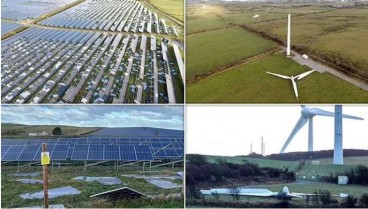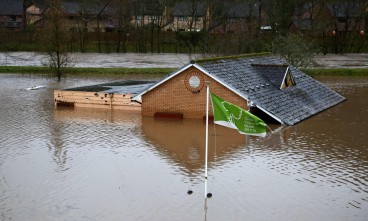From Cracks to Collapse: The Impact of Storm Eowyn on Historic Structures

The destructive force of Storm Eowyn has left an indelible mark on the UK and Ireland, wreaking havoc with its deadly winds that reached speeds of up to 114mph. Described as the most powerful storm to hit the region in over a decade, Eowyn caused widespread damage, power outages for over a million residents, and significant travel disruptions. Tragically, the storm claimed two lives, one in Ireland and one in Scotland, as falling debris and uprooted trees turned lethal.
One of the most dramatic incidents occurred in Hale, Greater Manchester, where a historic red-bricked building, dating back to the 1900s, succumbed to Eowyn’s wrath. Cracks had appeared in its walls earlier in the week, likely exacerbated by prior foundation excavations during planned renovations. As the storm intensified, the structure was no match for the gale-force winds, eventually collapsing into a cloud of dust and rubble. Nearby businesses had already been evacuated as a precaution, and the road surrounding the site was completely cordoned off. The building, which had been vacant for two years, is now set for a controlled demolition to ensure public safety.

The Engineering Challenges of Aging Structures
Storm Eowyn’s devastation highlights the vulnerability of aging infrastructure, especially historic buildings that were constructed using methods and materials no longer aligned with modern engineering standards. The collapsed Hale property serves as a sobering example of how environmental forces can exploit structural weaknesses, such as cracking walls and compromised foundations. Renovation projects, like the one planned for this building, must carefully account for the structural integrity of adjoining properties to avoid catastrophic outcomes.
For civil engineers, this event underscores the importance of proactive measures, including regular inspections, reinforcement of foundations, and adherence to strict building codes designed to withstand extreme weather events. Engineering solutions, such as retrofitting and advanced materials, are crucial for preserving historic structures while ensuring public safety.
The Storm's Larger Lessons
Storm Eowyn is a stark reminder of the growing challenges posed by extreme weather events, which are predicted to become more frequent and intense due to climate change. Communities must prioritize infrastructure resilience by investing in preventative measures, from improved drainage systems to robust building designs. Collaboration between local authorities, engineers, and policymakers is essential to mitigate future risks.
Check out the following video for more information on the destructive force of Storm Eowyn.
Sources: mirror.co.uk, dailymail.co.uk, express.co.uk
Want to read more like this story?
Worst ever summer storm hit the Netherlands
Jul, 06, 2023 | NewsStorm Poly, the most severe storm occurring during summer months, and overall strongest since Janua...

Storm Amy Triggers Building Collapse on Top of Car in Glasgow City Centre
Oct, 03, 2025 | NewsA partial building collapse occurred in Glasgow’s city centre on Friday, October 6th, as Storm Amy...

Storm Floris Forces Emergency Infrastructure Response in the UK
Aug, 04, 2025 | NewsOn August 4, 2025, Storm Floris brought severe disruption across Scotland, affecting transport syst...

Solar Farms and Wind Turbines Tested and Failed by Storm Darragh
Dec, 09, 2024 | NewsStorm Darragh has highlighted the vulnerabilities of renewable energy infrastructure to extreme wea...

Heritage Lost: Winter Storm Claims 175-year-old Ravenscourt Grade II Listed Building
Jan, 15, 2025 | NewsThe brutal winter storm sweeping through the UK and Europe has claimed its latest victim: the 175-...

Storm Babet causes widespread damage in Ireland and the UK
Oct, 18, 2023 | NewsStorm Babet made landfall in the United Kingdom on the 18th of October and has since caused widespr...

Civil Engineering News Recap of January 2025
Feb, 06, 2025 | NewsYou can now find TheCivilEngineer.org's latest news recap video on YouTube, which includes what we...

Storm Dennis struck the United Kingdom: Floods, landslides and structural failures reported
Feb, 17, 2020 | NewsShortly after the impact of Storm Ciara, the United Kingdom was struck by another powerful tempest...

Tilted Structure in Kolkata, the Inferior Materials and Red Flags on Construction Standards
Jan, 14, 2025 | NewsIn a densely populated area of Kolkata, a four-story building in Vidyasagar Colony, Ward 99, Jadavp...
Trending

Vertical gardens in Mexico City to combat pollution

Characteristics of Load Bearing Masonry Construction

Taipei 101’s impressive tuned mass damper

Morocco Implements Landmark Dam Perforation to Combat Water Stress in Marrakech

Dutch greenhouses have revolutionized modern farming

The Line at Neom faces feasibility reassessment while construction continues

A new chapter for Sunderland: The £31 million Keel Crossing opens

